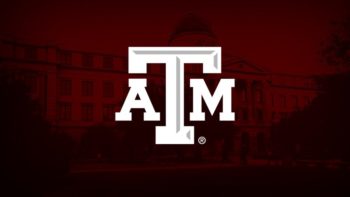Texas A&M Research: A Legacy Of Discovery
 From its humble beginnings in 1876 on the prairies of Central Texas, Texas A&M University has been conducting research that is changing the world and affecting life on every continent.
From its humble beginnings in 1876 on the prairies of Central Texas, Texas A&M University has been conducting research that is changing the world and affecting life on every continent.
The Morrill Act of 1862 was a big first step by providing means in which states could sell off public tracts of lands and use the proceeds to establish universities. These land-grant universities would go on to become world leaders in research. Today, the nation’s 74 land-grant universities — included among them Texas A&M — are world leaders in producing research that is literally life-changing.
“Without question, Texas A&M is one of the nation’s leading research institutions,” says President R. Bowen Loftin.
“Inquiry and discovery are at the heart of who we are as a research university, and involve not only our faculty, but also our undergraduate and graduate students. Texas A&M’s research expenditures of more than $700 million are annually among the largest of any U.S. university, and as one of a select few land-, sea- and space-grant universities, we conduct research that affects every form of human endeavor.”
Not long after Texas A&M first opened its doors, the Hatch Act was passed in 1887 that created the Agricultural Experiment Station, known today as the Texas A&M AgriLife Research. Research within the A&M System agency has been nothing short of amazing — touching every aspect of life for all Texans and beyond.
In 1914, several key developments began that provided a big boost to Texas A&M research. The Smith-Lever Act created the Agricultural Extension Services, which led to the creation of the Texas A&M AgriLife Extension. Also that year, the Texas A&M Forest Service and the Texas A&M Engineering Experiment Station “now all members of the A&M System were established to provide more outreach for transfer of engineering knowledge and expertise to the state’s residents.”
A year later, a truly historic event occurred for the state when Texas A&M’s School of Veterinary Medicine was established in 1915. Today, known as the College of Veterinary Medicine & Biomedical Sciences, the college is the only such veterinary school in the state and one of the world’s largest with a reputation to match. “Aggie vets” are hired by industry, the military, and homeland security and are used in private practice to provide the finest veterinary care in the world. Mark Francis was named the college’s first veterinary dean in 1916, and he led a team of researchers that were pioneers in creating animal immunizations that eradicated Texas Tick Fever, which was critical to the rapid development of Texas’ huge livestock industry.
More key milestones occurred. In 1919, the Texas A&M Engineering Extension Service was created, charged with “developing a highly skilled workforce through technical and vocational training,” and in the 1930s, as the Dust Bowl ravaged through the Midwest, Texas A&M’s extension agencies in agriculture and engineering were used in maintain water and soil conservation, crop rotation and range management.
By the 1940s, Texas A&M was awarding doctoral degrees in agriculture and engineering, a legacy that continues today: the Dwight Look College of Engineering currently is ranked No. 8 nationally among all engineering schools in the nation by U.S. News and World Report and the College of Agriculture and Life Sciences is among the nation’s largest and most prestigious.
In 1950, with Texas’ population growing and more vehicles on the road, the state created the Texas A&M Transportation Institute (TTI) to meet the new challenges of the region’s transportation system. Today, research at TTI extends to all corners of the world, including vehicle emission studies to highway safety and acclaimed research in traffic congestion.
Also, in 1950, the U.S. Congress approved creation of the National Science Foundation, a vast agency to improve and widen virtually every aspect of mankind’s existence and to provide funding for universities for further scientific exploration. Texas A&M has been a key player in a wide range of NSF projects, and today, NSF remains the largest funding source for research at the university.
Gen. James Earl Rudder was named Texas A&M’s 16th president in 1959, and he laid the groundwork for the school to become the Tier 1 research institution it is today by improving academic and faculty standards and expanding its research goals and stature. By 1963, Texas A&M gained university status and officially became Texas A&M University.
During the 1960s, Texas A&M’s space research became greatly enhanced with then-President John F. Kennedy’s goal to put a man on the moon, and key contracts were awarded to the university for space engineering. Also about that time, Texas A&M was awarded $3 million by the U.S. Atomic Energy Commission to construct a cyclotron, which in turn created the Nuclear Science Center on campus. The university went on to award the first nuclear engineering degree in the Southwest.
In 1971, Texas A&M took another huge step by becoming one of the country’s first Sea Grant Colleges, paving the way for the establishment of Texas A&M University at Galveston, which is considered the school’s “campus by the sea.” In conjunction with the Texas Maritime Academy, Texas A&M at Galveston has produced thousands of Sea Aggies who are employed by cruise lines, shipping companies and the energy sector, and marine-oriented research has produced landmark discoveries in sea life, hurricane and storm surge protection methods and beach erosion studies.
More milestones: In 1981, research expenditures topped $100 million for the first time, and Texas A&M became part of the Integrated Ocean Drilling Program in 1985. In 1989, Texas A&M received space grant status from NASA, beginning at long-standing affiliation with the space agency that continues to this day. Today, Texas A&M is one of only 17 institutions in the country to hold the triple designation as a land-grant, sea-grant and space-grant university.
By the 1990s, Texas A&M had surpassed $300 million in research expenditures (1992) and in 1997, the George Bush Presidential Library and Museum opened to promote discussion and research in the American political system.
In 1999, the Texas A&M Health Science Center opened, and today it prepares hundreds of Aggies each year to enter the medical, nursing and health science fields. In 2000, Texas A&M became a member of the prestigious Association of American Universities (AAU), comprising the top 62 leading public and private universities in the country put the school “on the leading edge of innovation, scholarship and solutions that contribute to the nation’s economy, security and well-being,” according to its charter in the group.
A major breakthrough in research occurred in 2001 when Texas A&M successfully cloned the first domestic animal — a cat named CC for “carbon copy.” Since then, the university has become an international leader in cloning and was the first to clone a deer, horse, pigs, cattle and others.
In 2003, Texas A&M University at Qatar was established to bring engineering programs and much-needed research to the Gulf Region by establishing a branch campus at Education City in Doha. Today, Education City is a multi-university campus of 2,400 acres housing several American universities.
In 2004, the Texas Veterinary Medical Diagnostic Laboratory was selected to be part of the National Animal Health Laboratory Network, and also that year the school joined a consortium of universities to build the Giant Magellan Telescope in Chile that will be the most powerful telescope ever constructed, enabling new discoveries across the universe. Also in 2004, the National Center for Foreign Animal and Zoonotic Disease Defense (FAZD) was established at Texas A&M as part of the Department of Homeland Security Science and Technology Center of Excellence, focusing on animal diseases and their possible transfer of diseases to humans.
More breakthroughs continued as the decade continued, including in 2006 when researchers completed the first conversion of a nuclear reactor from using highly enriched uranium. And in 2007, research expenditures at Texas A&M topped $500 million for the first time. The coming years also showered national rankings on the university, its colleges and academic programs.
In 2012, research at Texas A&M garnered international headlines as the school was awarded a $285.6 million contract to establish the Texas A&M Center for Innovation to help the nation’s emergency preparedness against emerging infectious diseases, including pandemic influenza and chemical, biological, radiological and nuclear threats. The purpose of the Center for Innovation is to perform research and advanced development to accelerate vaccines and other medical products through pre-clinical and clinical development and to produce these products in cases of pandemics or other national emergencies.
By 2013, research expenditures had reached $705 million at Texas A&M, and the school — by any measure and any standard — has become one of the world’s leading research institutions.





